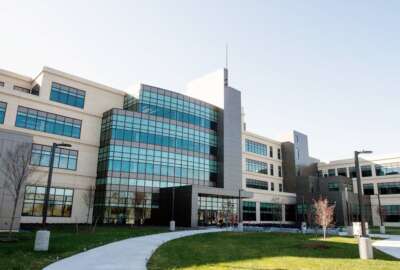What’s inside the new strategy of the Defense Logistics Agency
Citing the fact that the armed services are all undergoing transformation, the Defense Logistics Agency is striving to keep up with a new strategic plan.
Citing the fact that the armed services are all undergoing transformation, a crucial combat support agency is too. The Defense Logistics Agency is striving to keep up with a new strategic plan. The DLA director, Army Lt. Gen. Mark Simerly, joined the Federal Drive with Tom Temin to discuss.
Interview transcript:
Tom Temin: All right. So I thought the most telling point was the transformation, the basic change transformative era. You called it for the armed forces themselves that you support. Tell us what are the major trends you see there that would cause DLA to need a refreshed strategy?
Mark Simerly: Tom, thanks for that question. So I would say there’s three things to know about DLA to give you context for that question. No. 1, we’re the nation’s logistics combat support agency. We support military formations and capabilities around the globe with food, fuel, energy uniforms, medical supplies, construction material, spare parts and more. The second item is that we’re a worldwide organization. More than 25,000 employees subordinate support in the combatant commands in 28 countries. The sun literally never sets on DLA. And the third part is, as the Department Defense continues through this transformational era, DLA is challenging itself to transform alongside our partners in the military. Recently, Secretary of Defense Lloyd Austin spoke about the need to strengthen the resiliency of the supply chains that are critical for national security. That’s DLA’s focus as well and very much reflected in the new strategy. And so we see all of the services, all the combatant commands and the department shifting to face the challenges of future warfare and even the changing character of war. And that means we have to shift as well. So we can mean in stride, in some cases, be ahead of need in the case of the Department of Defense.
Tom Temin: And of course, your job, if you break it down to the basics, is getting stuff to the people where they need it and when they need it in the right quantities and have the supply chain issues that affected industry and still continue to. I guess maybe it started in COVID, but there are other causes too. Do you find that those affect the DLA as well?
Mark Simerly: Yeah, absolutely. I think the entire department is affected by a lot of the supply chain challenges that we see in the commercial realm. So certainly there’s some workforce challenges. There’s an evolving pace of technology that’s being introduced. There’s access to materials. So those are common challenges that we see and certainly what we intend to address in this strategy. And I would say as we look at this drive to calibrate a more resilient posture through precision, that’s a component of our plan that’s going to allow us to be more precise about the way we define requirements and more precise in the demand signal we give industry, which is really the source of our supply, so they can better calibrate their support to us with greater lead time.
Tom Temin: And you, of course, as you mentioned, use mostly commercial items ultimately or specified, say for the services, but made by commercial industry, whether food or uniforms and so on. But the means by which materials get around the world. Isn’t that also mostly dependent on the commercial transportation system? In other words, there’s not Navy ships delivering DLA supplies to Navy ships?
Mark Simerly: Well, I would say it’s a combination. We certainly have a reliance upon commercial transportation. We also operate within the defense transportation system led by our partner USTRANSCOM. And so there’s a there’s a mix between military cargo and then commercial freight that moves around the globe, some by air, some by surface as well. But we see the challenges that we have with supply chains in peacetime right now as being indicative of the challenges that we might face in conflict. And it’s really this concept of contested logistics where we see that logistics will be contested at all levels of war, tactical, operational, strategic, even in the homeland and also in all domains. So in the air, in space and the land, sea and in the cyber domain as well. And that’s what’s really causing us to make this shift. We understand our adversaries intend to attack a vulnerability that they perceive within our logistics capabilities, which underpinned all of our ability to conduct combat operations. And so we have to add resilience to our posture so that we cannot only anticipate attacks, but be better prepared to respond to them through stronger networks, stronger means to transport items across the globe, dispersion. There’s many other ways that we’re going to have to modify our approach so that we can ultimately meet our responsibilities across the globe.
Tom Temin: I mean, fair to say that in conflict, should that happen, that battle plans are interesting, but without logistics, they don’t help much.
Mark Simerly: Well, absolutely. We understand that logistics is the baseline of all combat power. And without that, we’re not going to be able to continue operations. And, of course, we’re concerned about not only a short, sharp conflict, but also protracted warfare. So having the resilience in our supply chains, having the right commodities in the right place, not only at the beginning of the war, but the ability to assure support throughout a conflict is really what we have to focus on. And that’s why we understand that we have to think, act and operate differently. We have to think about the challenges of war fighting clearly as we craft solutions. We have to act in ways that generate greater readiness and resilience today for the future fight that we have to operate in a way that it allows us to act with precision in all of our communications to industry so we can generate greater decision advantage and be better prepared to support and anticipated requirements.
Tom Temin: We’re speaking with Lt. Gen. Mark Simerly. He is director of the Defense Logistics Agency. And so let’s go into some detail about what’s going to change that. And for DLA to be more precise and to be more accurate in what is needed and so on. What are you going to do differently here?
Mark Simerly: Well, there’s quite a few things that we’ve envisioned that have to change in the organization for us to be relevant in the future. And it’s really based upon our organizing principle for our strategy, which is based upon four transformation imperatives: people, precision, posture and partnerships. And with our people, we understand we have to build organizational agility through our culture and our people having the right skill sets, being motivated by an understanding of the future battlefield and requirements and having the right culture that allows people to continue to grow and develop in our organization. With precision, that’s about calibrating resilient and responsive logistics solutions. So being able to employ state of the art tools, analytical tools so that we can achieve what we call decision advantage over our adversaries, we can think faster and better than them. So certainly that means improvement in our digital interoperability, the way we exchange data from end to end in the supply chain, but also application of tools like artificial intelligence and machine learning to help us think faster and better about problem sets and solutions that we devise. And then I would say the third imperative is posture. So this is increasing our ability to support integrated deterrence across the globe. And we think about posture in three ways. First one is presence. So having the right people with the right skill sets positioned across the globe so that they can maintain the relationships, the access, the permissions and gain the situational understanding that is simply really difficult to do unless you’ve got people on the ground. The next element is position and that’s really the traditional way that we think about posture. That’s where we have material for deployed across the globe and dispersed. So we’ve got adequate resilience within those supply chains and being able to act with precision. So we’re really putting the right stuff that we’re going to consume in the right quantities at the right time. And then the final element is partnership. And so certainly partnerships within the joint force ensuring that we are calibrating our support for the diverse requirements of all the military services and the combatant commands. Also being able to partner with our regional partners, our allies and partners across the world so we can integrate support. The era of logistics being a national responsibility and coalition fight is really over. And then the third element of partnerships that I’d say is industry, right? So really important for us to be able to work with the industry to understand challenges and in generating resilience within their supply chains that contribute to ours and to give them good demand signals so they can better anticipate requirements as well.
Tom Temin: And I was wondering, since as you point out, the DLA is delivering everything except ordnance and that’s comes from different elements. Are there insights or practices that you can share, though, with those elements that do deliver the ordnance in the kinetics and the energetics so that better coordination of those and what DLA is delivering?
Mark Simerly: Yeah. So I think there’s definitely some intersection of supply chain responsibilities. And even though DLA doesn’t directly deliver munitions or develop munitions, that’s really a service responsibility. We still have components that contribute to it. As you mentioned, there’s critical materials that are part of those supply chains that we have to illuminate and ensure provide the necessary material, but also the distribution. And so as we address some of the challenges with distributing material across the globe, especially from the strategic to the operational down to the tactical realm. We have the same challenges, especially as we look at the Pacific in the tyranny of distance and the challenges of getting things down to that last tactical mile. So there’s collaboration that’s necessary there. The other thing that I’d add is many of our munitions are produced in what we call our organic industrial base. Those government-owned facilities and government-operated facilities that the services have. And so there’s a lot of investment that all the services are making into their organic industrial base. We see an opportunity for DLA to help strengthen that by helping to put demand signals on their capabilities in areas such as advanced manufacturing and, for instance, for spare parts so they can have a more robust capability that gives us resilience within our supply chains and is able to help us respond in time of need, especially as we’re employing obsolete equipment that our partners may be using, such as in Ukraine.
Tom Temin: Sure. And finally, the organic industrial base has started to get some money actually from Congress to update. So that’s encouraging news. And on the people front for DLA, I mean, logistics, logisticians, that’s a highly specialized craft, really a profession to do that. What and it’s mostly civilians that are working at DLA, correct? What do you need to do with the workforce in terms of training or recruiting?
Mark Simerly: It’s a great question. And yeah, we’re about 94% civilian in this agency of 25,000 people, and about 40% of us have served in uniform at some point in our career. So in terms of that workforce development, I would say No. 1 is helping to inspire people to serve their nation. That’s really the sacred responsibility that we have and that appeals to so many people, that element of service, especially the millennial generation and also the Gen Z generation that appeals to them, that opportunity to serve their nation. But also we have to give them relevant skill sets. And as you mentioned, we’ve got quite a few areas of expertise that are quite specialized in procurement specialists, specialists in particular career fields, as you might imagine, say, for instance, medical supplies quite different from food or fuel. Terms of those specific skill sets and understanding the commodity. So there is a specific education that we have to apply to those personnel as we bring them on board. And of course, we recruit folks with specific skill sets, but we have to amplify them when they arrive here. One element that we’re really focused on the centerpiece of this strategy is in order to take advantage of the digital tools that are emerging, we have to have data acumen throughout our formation. So we don’t necessarily need many more data scientists or data engineers, but we need leaders at all echelons who can apply data successfully, can visualize data and put it into use in their decision making. And so that’s an area that we’re focused on to generate that data acumen within our workforce. We think that’s going to help us with recruitment and retention as well. Generation Z and millennial workers really expect us to have state of the art tools. And so that’s part of our transformation is to provide better tools, but also provide the entire workforce better means to use them.
Tom Temin: And ideally, I guess a really smart DLA would know what a combatant command needs before that. Combatant command knows it needs it.
Mark Simerly: So, Tom, I absolutely agree. We have an obligation to understand the warfighting concepts and capabilities of all the services so that we can anticipate requirements in advance of need. That means better harmonization of demand signals between DLA in the services. And this gets to digital interoperability as well as stronger integration and in war plans as an example. But also being able to translate that to our workforce so they can take action at Echelon to make the right decisions, to have commodities in motion or stored in the right quantities and forward positions. So this exquisite understanding of the war fighting conditions and how they’re changing is essential for our culture and for our workforce to understand in order for us to be effective.
Tom Temin: Army Lt. Gen. Mark Simerly is director of the Defense Logistics Agency. Thanks so much for joining me.
Mark Simerly: Tom, really thanks for the opportunity to discuss DLA. Certainly, this agency is critical to our nation and it’s at a critical time. Last week, Gen. Randy George, the Chief of staff of the Army, said all of us have to got have got to have the same sense of urgency about transforming our army to meet the needs of our nation in today’s volatile operating environment. That applies to all services and it certainly applies to DLA. So we have a sense of urgency as we change. But also within that, we have to have a sense of clarity and that’s what’s intended in our current strategy called DLA Transforms.
Copyright © 2025 Federal News Network. All rights reserved. This website is not intended for users located within the European Economic Area.
Tom Temin is host of the Federal Drive and has been providing insight on federal technology and management issues for more than 30 years.
Follow @tteminWFED







